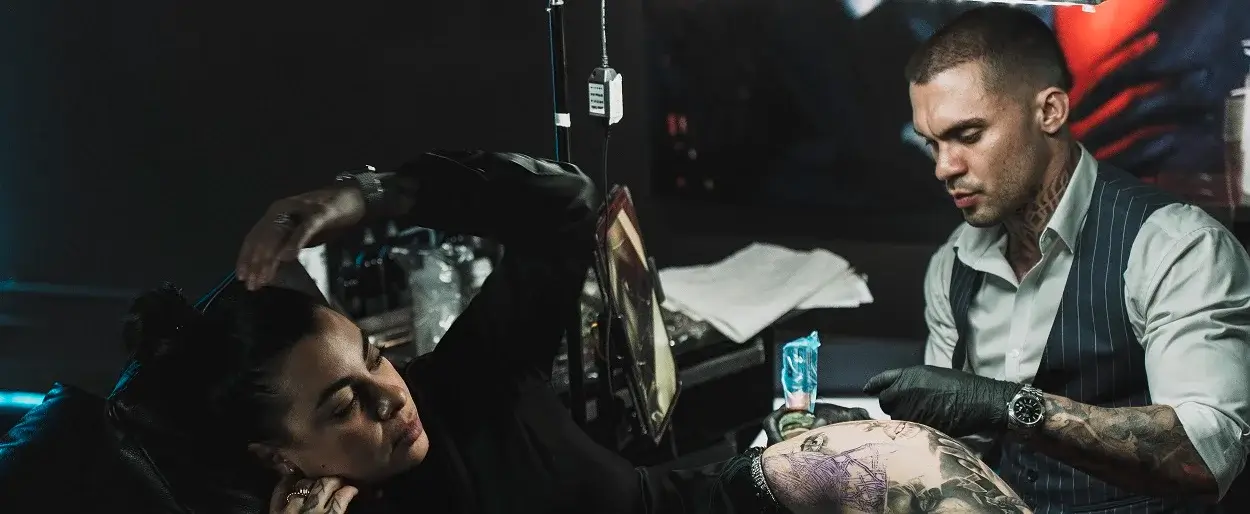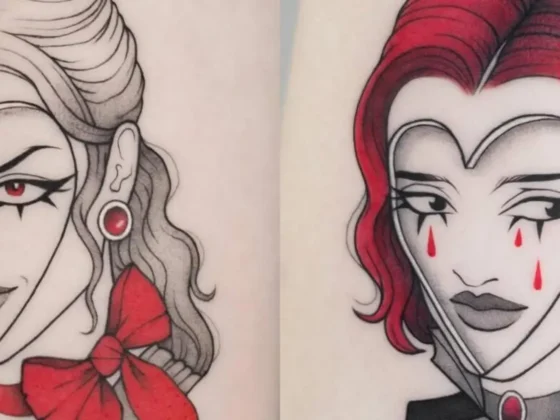Inked Mag Staff
November 12th, 2014
Blood is Thicker than Paint
Dive into the world of blood painting with artist Vincent Castiglia. Learn about this intriguing art form and the creative process behind it.
There’s something truly classic about commissioning your own portrait, especially in a modern world plagued by the selfie surge and harsh realities of unedited photographs. It’s a breath of fresh air to see the artistic renditions and creative licenses an artist can employ when depicting someone’s likeness on canvas with whichever medium the patron and artist settle on. If you’re comedian Margaret Cho, however, you’re going to want to use blood, and lots of it.
It may sound a little macabre, but blood painting has been a phenomenon going on for quite some time now. Vincent Castiglia is a New York-based artist known for working in two of the most intimate media in the world, tattooing and blood painting. When he isn’t slinging ink, he finds himself drawing his own blood to create his insane, dark master canvases. With some of his pieces extending up to 7-feet tall, it is no wonder that he’s caught the attention of art lovers like Cho. “The initial inspiration to work with blood was to connect with my work on the most direct, most personal level possible,” says Castiglia who has been experimenting with blood painting since 2000. “Something ultimately truthful was being communicated with that substance. When I started working with it I felt a connection that I didn’t feel with any other medium. Something real was happening and I couldn’t have imagined working in anything else but that from there after.”

Cho decided not only to ask Castiglia to do her portrait, but offered to use her own blood instead of his. “She initially had asked if I could do it in her menstrual blood,” explains Castiglia, “and as cool of an idea as that is, I let her know there’s just not enough blood of that kind to do a full scale painting.” For Cho’s portrait Castiglia needed to collect 12 six-milliliter vials of her blood and use it as sparingly as possible. “I had preferred working in my own [blood] for as long as I’ve been doing this,” Castiglia continues. “I recently arrived at a place where I questioned whether or not I needed to use mine specifically anymore. A lot of energy needed to be released by using my blood and reconstituted on these canvases so that I could understand this world a little better. I’m not sure that I need to do that anymore. So this [commission] actually came at a really interesting time.”

After digitally laying out the sketched concept for the painting and collecting all the blood he would need from Cho, the tattooist-turned-experimental-artist then began to paint. “These canvases are white,” explains Castiglia. “All I’m dealing with is the white of the paper, so I’m developing all of the dark tones and all of the hot spots by not painting and painting around it. It’s the same principal as doing monochromatic black and grey work in tattoos. I’m also working gloved up the whole time. That’s another sort of thing that other painters don’t have to think about that I do.”
The portrait took about six months to complete with its grand unveiling to Cho happening earlier in October. “The piece really captured Margaret’s essence,” says Castiglia. “Part of my visual language is decay, but I didn’t want this to be something gory or perceived as gory, so I took it in the direction of a stone bust–something that had a classical aesthetic but then also communicated something else about her. I represented the decay in terms of cracks throughout the stone. It was a nice middle ground.” Who said you can’t turn blood into stone?

This portrait has become a huge landmark for Castiglia. Not only does it represent an extension of his painting from his own blood to others’, but it has also begun the trend of sanguineous portraits to come. Up next for Castiglia is the commission to bring to life the portrait of the filmmaker John Borowski, known for his documentaries on serial killers. As Borowski’s art focuses on those whose lives have revolved around blood, it seems like Castiglia’s signature style will prove to be the perfect fit.
Editor's Picks
Bridging Classical Art and Modern Tattooing
Esteban Rodriguez brings the discipline of classical fine art to the living canvas of skin, creating hyper-realistic tattoos that merge technical mastery with emotional depth.
Show Your Ink Fashions Brings Custom Style to Tattoo Culture
Show Your Ink Fashions creates custom shirts designed to showcase your tattoos as wearable art, blending fashion with personal expression.
The Ultimate “Superman” Tattoo Roundup: Just in Time for Superman’s Return to Screens
With Superman’s big return to theaters, fans are revisiting some of the most iconic ink inspired by the Man of Steel.














